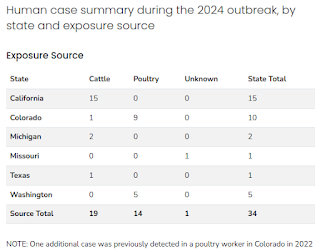Late yesterday the CDC published their weekly H5 update, which added 3 more poultry-related human infections in Washington State (n=5), bringing the total number of human cases in 2024 to 34 across 6 states.
Given that only one U.S. case had been reported prior to April of this year (in Apr 2022), this is a significant departure from what we've seen in the past. Not only are these numbers are likely to rise, they also likely under represent the true number of cases.
We've seen multiple anecdotal reports indicating that some (perhaps many) symptomatic farm workers have refused to be tested for the virus (see EID Journal: Avian Influenza A(H5N1) Virus among Dairy Cattle, Texas, USA), and that describe a general reluctance of many farm owners to cooperate with investigators.
Despite that fact that better testing in California and Colorado have turned up many more (previously unsuspected) infected farms, testing for the virus in cattle (and bulk milk) remains sporadic - and largely voluntary - across the country.
`Don't test, don't tell' may serve the short-term interests of the dairy industry - but it only hides the problem - it doesn't solve it.
The good news is that there is still no sign of human-to-human transmission of the virus, although the regrettable lack of testing limits our ability to make definitive statements. This remains an evolving situation.
Some excerpts from last night's CDC update, after which I'll have a postscript.
H5 Bird Flu: Current Situation
WHAT TO KNOW
H5 bird flu is widespread in wild birds worldwide and is causing outbreaks in poultry and U.S. dairy cows with several recent human cases in U.S. dairy and poultry workers.
While the current public health risk is low, CDC is watching the situation carefully and working with states to monitor people with animal exposures.
CDC is using its flu surveillance systems to monitor for H5 bird flu activity in people.
Current situation
H5 Bird Flu Detections in USA
• Dairy cattle: Ongoing multi-state outbreak
• Wild Birds: Widespread
• Poultry Flocks: Sporadic outbreaks
• Mammals: Sporadic infections
• Person-to-person spread: None
• Current public health risk: Low
- 10,458 wild birds detected as of 10/22/2024 | Full Report
- 51 jurisdictions with bird flu in wild birds
- 103,620,541 poultry affected as of 10/25/2024 | Full Report
- 48 states with outbreaks in poultry
- 338 dairy herds affected as of 10/24/2024 | Full Report
- 14 states with outbreaks in dairy cows
These data will be updated daily, Monday through Friday, after 4 p.m. to reflect any new data.
Cumulative data on wild birds have been collected since January 20, 2022. Cumulative data on poultry have been collected since February 8, 2022. Cumulative data on humans in the U.S. have been collected since April 28, 2022. Cumulative data on dairy cattle have been collected since March 25, 2024.

Sentinel surveillance systems are important for the monitoring of respiratory viruses in the EU/EEA, but these systems are not designed and are not sufficiently sensitive to identify a newly emerging virus such as avian influenza in the general population early enough for the purpose of implementing control measures in a timely way.
Similarly, in 2023's analysis from the UKHSA (see TTD (Time to Detect): Revisited), there could be dozens or even hundreds of undetected human H5N1 infections before public health surveillance would likely detect them, potentially over a period of weeks or months.



